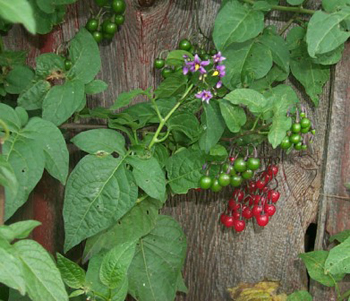Contents:
Common Names | Parts Usually Used | Plant(s) & Culture | Where Found | Medicinal Properties
Uses | Warning | Bibliography
Scientific Names

- Common Nightshade
- Solanum nigrum L.
- Woody Nightshade, Bittersweet
- Solanum dulcamara L.
Common Names
Solanum dulcamara:
- Bittersweet nightshade
- Bittersweet
- Bittersweet herb
- Bittersweet stems
- Bittersweet twigs
- Blue nightshade
- Felonwort
- Fever twig
- Garden nightshade
- Mortal
- Nightshade
- Nightshade vine
- Scarlet berry
- Staff vine
- Violet bloom
- Woody
- Woody nightshade
Solanum nigrum:
- Black nightshade
- Common nightshade
- Deadly nightshade
- Garden nightshade
- Poisonberry
Parts Usually Used
Solanum dulcamara: bark of the root, twigs.
Solanum nigrum: leaves, herb.
Back to Top
Description of Plant(s) and Culture

Any of several of the plants of the genus Solanum are called nightshade.
Solanum dulcamara is shrubby, thumb-thick, ashy-green, somewhat angular, climbing stem can reach a length off up to 10 feet. The dark green (or purplish when young) leaves are alternate and variable in shape (may be cordate, landeolate-ovate, or hastate). The purple, star-shaped flowers appear in paniculate clusters on shore lateral or terminal peduncles from May to August. The fruit is a scarlet, bitter berry that hangs on the vine for months after the leaves have fallen.
Solanum nigrum (black nightshade): its erect, angular, branching stem grows 1 to 2 feet high and may be glabrous or covered with inward bent hairs. The leaves are alternate, dark green, ovate, and wavy-toothed or nearly entire. Drooping, lateral, umbel-like clusters of white or pale violet flowers appear from July to October. The fruit is a many-seeded, pea-sized, purple or black berry.
Back to Top
Where Found
Solanum dulcamara is a perennial woody vine found in moist areas, around houses, and among hedges and thickets in the eastern and north-central states, the Pacific coast, and in Europe. This common woody vine is found around barnyards and waste places.
Solanum nigrum (black nightshade) is an annual plant found in gardens and along old walls and fences in various parts of the U.S. and southern Canada.
Back to Top
Medicinal Properties
Solanum dulcamara: anodyne, diuretic, emetic, herpatic, purgative.
Solanum nigrum: diaphoretic, narcotic, purgative.
Back to Top
Uses
Solanum dulcamara:
Although bittersweet nightshade is a relatively weak poison, it is used almost exclusively for external problems. Use it as a poultice for gout, herpes, furuncles, warts, ringworms, shingles, old ulcers, and felons. Combined with chamomile it makes a good ointment for swellings, bruises, sprains, and corns. For skin diseases and sores, combine with yellow dock.
Dulcamara is used as a starting material for steroids and is confirmed by scientists to be significant in anti-cancer activity.
Solanum nigrum:
Taken internally in very small amounts, the leaves strongly promote perspiration and purge the bowels the next day. The juice of the fresh herb is sometimes used for fever and to allay pain. In large doses, black nightshade can cause serious, but usually not fatal, poisoning. Externally, the juice or an ointment prepared from the leaves can be used for skin problems, cancers, and tumors. The berries are poisonous, but boiling apparently destroys the toxic substances and makes them usable for preserves, jams, and pies. Extracts used in tea in India, China, Europe, Japan, Africa, etc.
Back to Top
Warning
Bittersweet nightshade (solanum dulcamara) should not be taken internally without medical supervision. Contains steroids, toxic alkaloids, and glucosides. Will cause vomiting, vertigo, convulsions, weakened heart, and paralysis.
Take black nightshade internally only under medical supervision. Some varieties contain solanine, steroids; deaths have been reported from use. In India, some varieties are eaten as vegetables, but similar varieties may be violently toxic.
There is a deadly nightshade; be sure not to confuse them. Even so, use moderately.
Back to Top
Bibliography
![]() Eastern/Central Medicinal Plants
Eastern/Central Medicinal Plants, by Steven Foster and James A. Duke., Houghton Mifflin Company, 215 Park Avenue South, New York, NY 10000
![]() Culpeper’s Complete Herbal & English Physician: Updated With 117 Modern Herbs
Culpeper’s Complete Herbal & English Physician: Updated With 117 Modern Herbs, by Nicholas Culpeper, Meyerbooks, publisher, PO Box 427, Glenwood, Illinois 60425, 1990, (reprint of 1814)
 Taber’s Cyclopedic Medical Dictionary
Taber’s Cyclopedic Medical Dictionary, 15th Edition, F. A. Davis Company, 1915 Arch Street, Philadelphia, PA 19103
![]() Indian Herbalogy of North America
Indian Herbalogy of North America, by Alma R. Hutchens, Shambala Publications, Inc., Horticultural Hall, 300 Massachusetts Avenue, Boston, Massachusetts 02115, 1973
![]() Planetary Herbology
Planetary Herbology, by Michael Tierra, C.A., N.D., O.M.D., Lotus Press, PO Box 325, Twin Lakes. WI 53181., Copyright 1988, published 1992
![]() The Herb Book
The Herb Book, by John Lust, Bantam Books, 666 Fifth Avenue, New York, NY. copyright 1974.
